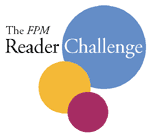
We’re looking for a few good ideas. And we know you’ve got them.
Fam Pract Manag. 2003;10(8):14

About a year and a half ago, FPM published a pair of articles that elicited more responses from readers than any other article or group of articles I can remember. They were “Going Solo: Making the Leap,” February 2002, page 29, and “Going Solo: One Doc, One Room, One Year Later,” March 2002, page 25, both by Gordon Moore, MD. They described an approach to practice so contrary to prevailing wisdom that we were led to ask Dr. Moore for a third article just to answer incredulous questions from readers (see “Answers to Your Questions on Solo, Idealized Practice,” May 2002, page 39).
Moore abandoned the idea of a high-productivity, high-complexity, high-overhead, high-pressure practice for the very opposite: By keeping his overhead lower than one would have believed possible, he found he could do very well for his patients and himself with a low-productivity, low-complexity, low-pressure practice. His idea was radical both in the sense that it departed radically from the norm and in the sense that it went back to the roots of family practice: He set up a one-room office with no staff the way a country GP might have in the 1940s.
What’s the big idea?
I mention Moore’s articles for two reasons. The first is straightforward: This issue contains another contribution from him. “Creating a Vital, Burnout-Proof Practice,” page 51, is not so much about his practice as about his philosophy of practice. The article presents Moore’s advice to other physicians on how to think about practice, particularly when they’re embarking on a new venture. I think you’ll find it stimulating and perhaps a bit provocative itself.
My second reason is that Moore’s approach to practice illustrates well what we have in mind in laying down the 2004 FPM Reader Challenge. As you’ll see from the announcement on page 24, we’re looking for readers who have “big ideas that have made a difference in FP’s practices.”
In some respects, I am hesitant to mention Moore’s ideas in this context, because the ideas we’re looking for certainly don’t need to be so big they inspire incredulity in those who hear about them. But we are looking for fresh thinking, for ideas that have made your practice better and have the potential to do the same for your colleagues if only they can hear about them. We’ll be soliciting reader contributions over the next few months, and we’ll plan to publish the ideas that our panel of judges considers the best.
No, you don’t have to be the originator of the idea. As long as it is not old hat to your colleagues – and the judges – any idea will do, assuming that you or a group you belong to has put it to work. Even the oldest ideas can be made new simply by being transplanted in a new context. Other fields abound with good ideas that are not yet widely known in family practice. Moreover, I know that family physicians are resourceful – both by nature and through force of circumstances. Think about your practice and all the ways you have made it better for you, your staff and your patients. I would bet that you’ve done something that you’re proud of and that you suspect may be new to many other family physicians. That’s what we’re looking for.
It’s not about writing
You might expect a reader challenge like this to be aimed at generating articles for the journal, but that’s not the point. We’re just trying to collect and share exciting ideas. Of course, if you have a full-blown article in you, we’ll be delighted to have it for review. To enter the challenge, though, you just need to answer the four questions listed in the announcement on page 24. (Yes, I’ll admit it: They’re essay questions. But this is an open-practice test.)
Please spend a minute thinking about ideas from your practice you could submit. Think, too, about colleagues of yours who might well be up to the challenge so you can pass the word to them. Then sit down to answer the questions about your idea, and send your entry off to FPM. Winners will be published in the September 2004 issue. Who knows? Maybe your idea will improve the lives of dozens of physicians and thousands of patients.